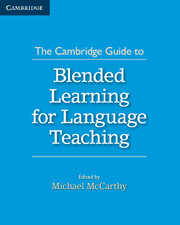Chapter 13 - Blended Learning in a Mobile Context: New Tools, New Learning Experiences?
Published online by Cambridge University Press: 22 September 2021
Summary
INTRODUCTION
The increasing popularity, ubiquity and affordability of mobile or ‘handheld’ devices has profound implications for language learning and in particular for blended learning (BL). Mobile devices are not just mobile in the sense of ‘portable’. They can make the learning experience itself mobile if the teacher is able to design pedagogically sound and imaginative communicative tasks that take the learning experience beyond the classroom walls.
These mobile-based ‘bridging’ activities can link learning that takes place inside the classroom with both formal and informal learning outside the classroom. Well-designed bridging activities exploit the unique affordances or capabilities of handheld devices to encourage learners to engage with their surroundings, and to both process and produce language, based on their experiences.
Features such as geolocation and augmented reality are already present in ‘smart’ mobile devices, and can support language learning. ‘Geolocation’ refers to the ability of an internet-connected device to pinpoint where you are geographically; ‘augmented reality’ technology superimposes information on the real world, via apps that can access a device's camera to provide an enhanced or ‘augmented’ view of reality. However, few teachers feel confident in designing tasks that utilise these features, which can present unique learning opportunities. It remains for teachers to both understand how these mobile device affordances can link to language learning objectives, and how to design effective classroom-based tasks around them. These mobile-based classroom-based activities may then, in turn, serve as a springboard to a more blended approach, using bridging tasks as a connecting principle between what happens in class, and what happens outside of it.
This chapter takes as its starting point Laurillard's (2012) observation that classroom practitioners need to become designers of effective learning experiences (see also the discussion of Laurillard's ideas in Mishan, Chapter 8, this volume), and explores that assertion in the light of a short action research project carried out with two different multinational classes of EFL learners studying in the UK over the summer of 2013. The project led – via an implementation of mobile-based tasks – to the development of six parameters for consideration with regard to effective design and sequencing of tasks in mobile contexts.
- Type
- Chapter
- Information
- The Cambridge Guide to Blended Learning for Language Teaching , pp. 219 - 233Publisher: Cambridge University PressPrint publication year: 2015
- 1
- Cited by

